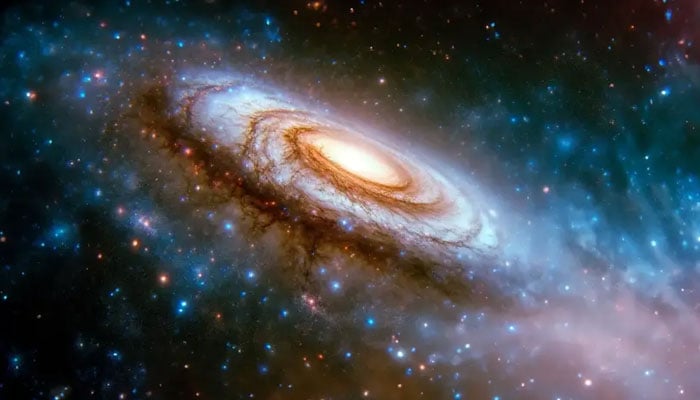[ad_1]

In a groundbreaking discovery facilitated by the James Webb Space Telescope, an international research team, featuring astronomer Alexander de la Vega from the University of California, Riverside (UCR), has identified the most distant barred spiral galaxy similar to the Milky Way ever observed.
The galaxy, named ceers-2112, challenges previous notions about galaxy evolution, indicating that barred spiral galaxies could form and exhibit order much earlier in the universe’s history than believed.
Published in the journal Nature, the research, spearheaded by scientists at the Centro de Astrobiología in Spain, sheds light on ceers-2112, which harbours a central galactic bar—a structure comprised of stars.
Traditionally, barred spiral galaxies like the Milky Way were thought to emerge after the universe reached half of its current age of approximately 13.8 billion years.
De la Vega, a coauthor and postdoctoral researcher in the Department of Physics and Astronomy at UCR, emphasised the unexpected nature of ceers-2112, challenging the prevalent belief that early-universe galaxies were primarily chaotic and lacked structures akin to the Milky Way.
The presence of a galactic bar in ceers-2112 suggests an accelerated maturation process, questioning existing theories on galaxy formation and evolution.
Previously, astronomers assumed that several billion years were required for galaxies to attain the level of order conducive to developing bars. However, the discovery challenges this timeframe, proposing that such structures can manifest in about one billion years or less.
De la Vega’s contributions to the research involved estimating the redshift and properties of ceers-2112, providing crucial insights into the galaxy’s characteristics and aiding in the interpretation of measurements.
The discovery not only prompts revisions to theoretical models of galaxy evolution but also opens new avenues for detecting similar structures in the early universe, marking a significant milestone in the field of astronomy.
[ad_2]
Source link

 Best Underground Water Leak Detection Equipment 2024
Best Underground Water Leak Detection Equipment 2024  Best Backyard Ideas: Turn Your Outdoor Area Into a Creative and Calm Haven
Best Backyard Ideas: Turn Your Outdoor Area Into a Creative and Calm Haven  Babar, Rizwan are good players but not whole team, says Mohammad Hafeez
Babar, Rizwan are good players but not whole team, says Mohammad Hafeez  Pak vs NZ: Green Shirts aim to bounce back against Kiwis today
Pak vs NZ: Green Shirts aim to bounce back against Kiwis today